4.6E: Exercises
- Page ID
- 30233
Practice Makes Perfect
Find an Equation of the Line Given the Slope and \(y\)-Intercept
In the following exercises, find the equation of a line with given slope and \(y\)-intercept. Write the equation in slope–intercept form.
slope \(3\) and \(y\)-intercept \((0,5)\)
slope \(4\) and \(y\)-intercept \((0,1)\)
- Answer
-
\(y=4x+1\)
slope \(6\) and \(y\)-intercept \((0,−4)\)
slope \(8\) and \(y\)-intercept \((0,−6)\)
- Answer
-
\(y=8x−6\)
slope \(−1\) and \(y\)-intercept \((0,3)\)
slope \(−1\) and \(y\)-intercept \((0,7)\)
- Answer
-
\(y=−x+7\)
slope \(−2\) and \(y\)-intercept \((0,−3)\)
slope \(−3\) and \(y\)-intercept \((0,−1)\)
- Answer
-
\(y=−3x−1\)
slope \(\frac{3}{5}\) and \(y\)-intercept \((0,-1)\)
slope \(\frac{1}{5}\) and \(y\)-intercept \((0,-5)\)
- Answer
-
\(y=\frac{1}{5} x-5\)
slope \(-\frac{3}{4}\) and \(y\)-intercept \((0,-2)\)
slope \(-\frac{2}{3}\) and \(y\)-intercept \((0,-3)\)
- Answer
-
\(y=-\frac{2}{3} x-3\)
slope \(0\) and \(y\)-intercept \((0,-1)\)
slope \(0\) and \(y\)-intercept \((0,2)\)
- Answer
-
\(y=2\)
slope \(-3\) and \(y\)-intercept \((0,0)\)
slope \(-4\) and \(y\)-intercept \((0,0)\)
- Answer
-
\(y=−4x\)
In the following exercises, find the equation of the line shown in each graph. Write the equation in slope–intercept form.
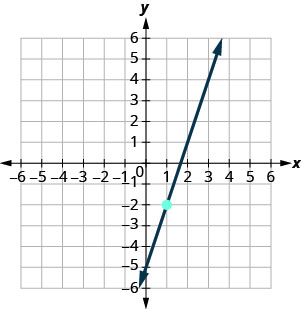
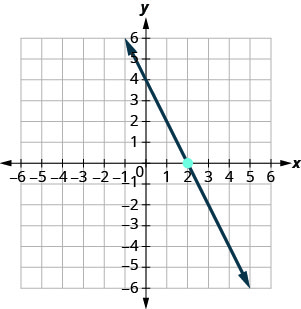
- Answer
-
\(y=−2x+4\)
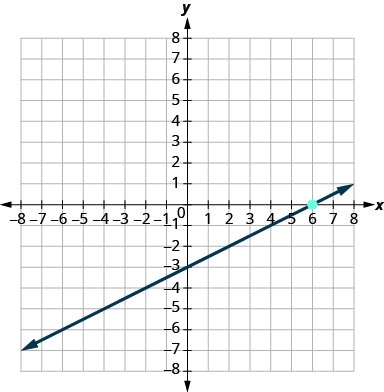
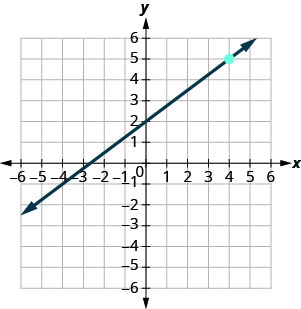
- Answer
-
\(y=\frac{3}{4} x+2\)
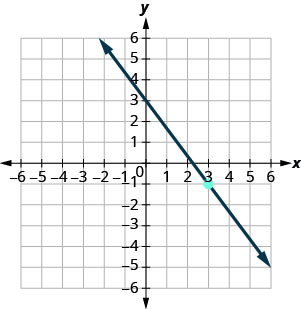
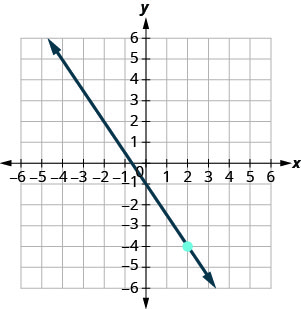
- Answer
-
\(y=-\frac{3}{2} x-1\)
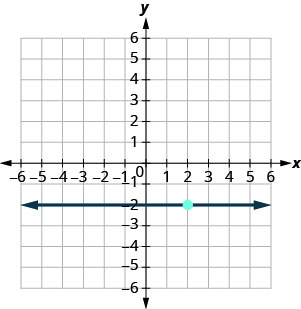
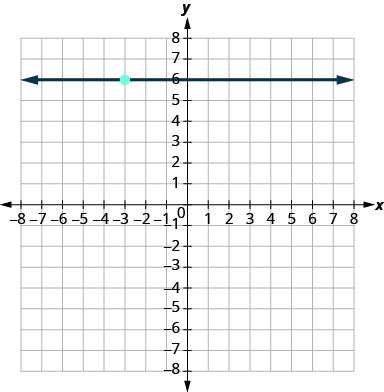
- Answer
-
\(y=6\)
Find an Equation of the Line Given the Slope and a Point
In the following exercises, find the equation of a line with given slope and containing the given point. Write the equation in slope–intercept form.
\(m=\frac{5}{8},\) point \((8,3)\)
\(m=\frac{3}{8},\) point \((8,2)\)
- Answer
-
\(y=\frac{3}{8} x-1\)
\(m=\frac{1}{6},\) point \((6,1)\)
\(m=\frac{5}{6},\) point \((6,7)\)
- Answer
-
\(y=\frac{5}{6} x+2\)
\(m=-\frac{3}{4},\) point \((8,-5)\)
\(m=-\frac{3}{5},\) point \((10,-5)\)
- Answer
-
\(y=-\frac{3}{5} x+1\)
\(m=-\frac{1}{4},\) point \((-12,-6)\)
\(m=-\frac{1}{3},\) point \((-9,-8)\)
- Answer
-
\(y=-\frac{1}{3} x-11\)
Horizontal line containing \((−2,5)\)
Horizontal line containing \((−1,4)\)
- Answer
-
\(y=4\)
Horizontal line containing \((−2,−3)\)
Horizontal line containing \((−1,−7)\)
- Answer
-
\(y=−7\)
\(m=-\frac{3}{2},\) point \((-4,-3)\)
\(m=-\frac{5}{2},\) point \((-8,-2)\)
- Answer
-
\(y=-\frac{5}{2} x-22\)
\(m=-7,\) point \((-1,-3)\)
\(m=-4,\) point \((-2,-3)\)
- Answer
-
\(y=-4 x-11\)
Horizontal line containing \((2,-3)\)
Horizontal line containing \((4,-8)\)
- Answer
-
\(y=−8\)
Find an Equation of the Line Given Two Points
In the following exercises, find the equation of a line containing the given points. Write the equation in slope–intercept form.
\((2,6)\) and \((5,3)\)
\((3,1)\) and \((2,5)\)
- Answer
-
\(y=−4x+13\)
\((4,3)\) and \((8,1)\)
\((2,7)\) and \((3,8)\)
- Answer
-
\(y=x+5\)
\((−3,−4)\) and \((5,−2)\)
\((−5,−3)\) and \((4,−6)\)
- Answer
-
\(y=-\frac{1}{3} x-\frac{14}{3}\)
\((−1,3)\) and \((−6,−7)\)
\((−2,8)\) and \((−4,−6)\)
- Answer
-
\(y=7x+22\)
\((6,−4)\) and \((−2,5)\)
\((3,−2)\) and \((−4,4)\)
- Answer
-
\(y=-\frac{6}{7} x+\frac{4}{7}\)
\((0,4)\) and \((2,−3)\)
\((0,−2)\) and \((−5,−3)\)
- Answer
-
\(y=\frac{1}{5} x-2\)
\((7,2)\) and \((7,−2)\)
\((4,2)\) and \((4,−3)\)
- Answer
-
\(x=4\)
\((−7,−1)\) and \((−7,−4)\)
\((−2,1)\) and \((−2,−4)\)
- Answer
-
\(x=−2\)
\((6,1)\) and \((0,1)\)
\((6,2)\) and \((−3,2)\)
- Answer
-
\(y=2\)
\((3,−4)\) and \((5,−4)\)
\((−6,−3)\) and \((−1,−3)\)
- Answer
-
\(y=−3\)
\((4,3)\) and \((8,0)\)
\((0,0)\) and \((1,4)\)
- Answer
-
\(y=4x\)
\((−2,−3)\) and \((−5,−6)\)
\((−3,0)\) and \((−7,−2)\)
- Answer
-
\(y=\frac{1}{2} x+\frac{3}{2}\)
\((8,−1)\) and \((8,−5)\)
\((3,5)\) and \((−7,5)\)
- Answer
-
\(y=5\)
Find an Equation of a Line Parallel to a Given Line
In the following exercises, find an equation of a line parallel to the given line and contains the given point. Write the equation in slope–intercept form.
line \(y=4 x+2,\) point \((1,2)\)
line \(y=3 x+4,\) point \((2,5)\)
- Answer
-
\(y=3 x-1\)
line \(y=-2 x-3,\) point \((-1,3)\)
line \(y=-3x-1,\) point \((2,-3)\)
- Answer
-
\(y=−3x+3\)
line \(3 x-y=4,\) point \((3,1)\)
line \(2 x-y=6,\) point \((3,0)\)
- Answer
-
\(y=2x−6\)
line \(4 x+3 y=6,\) point \((0,-3)\)
line \(2x+3y=6,\) point \((0,5)\)
- Answer
-
\(y=-\frac{2}{3} x+5\)
line \(x=-3,\) point \((-2,-1)\)
line \(x=-4,\) point \((-3,-5)\)
- Answer
-
\(x=−3\)
line \(x-2=0,\) point \((1,-2)\)
line \(x-6=0,\) point \((4,-3)\)
- Answer
-
\(x=4\)
line \(y=5,\) point \((2,-2)\)
line \(y=1,\) point \((3,-4)\)
- Answer
-
\(y=−4\)
line \(y+2=0,\) point \((3,-3)\)
line \(y+7=0,\) point \((1,-1)\)
- Answer
-
\(y=−1\)
Find an Equation of a Line Perpendicular to a Given Line
In the following exercises, find an equation of a line perpendicular to the given line and contains the given point. Write the equation in slope–intercept form.
line \(y=-2 x+3,\) point \((2,2)\)
line \(y=-x+5,\) point \((3,3)\)
- Answer
-
\(y=x\)
line \(y=\frac{3}{4} x-2,\) point \((-3,4)\)
line \(y=\frac{2}{3} x-4,\) point \((2,-4)\)
- Answer
-
\(y=-\frac{3}{2} x-1\)
line \(2 x-3 y=8,\) point \((4,-1)\)
line \(4 x-3 y=5,\) point \((-3,2)\)
- Answer
-
\(y=-\frac{3}{4} x-\frac{1}{4}\)
line \(2 x+5 y=6,\) point \((0,0)\)
line \(4 x+5 y=-3,\) point \((0,0)\)
- Answer
-
\(y=\frac{5}{4} x\)
line \(y-3=0,\) point \((-2,-4)\)
line \(y-6=0,\) point \((-5,-3)\)
- Answer
-
\(x=-5\)
line \(y\)-axis, point \((3,4)\)
line \(y\)-axis, point \((2,1)\)
- Answer
-
\(y=1\)
Mixed Practice
In the following exercises, find the equation of each line. Write the equation in slope–intercept form.
Containing the points \((4,3)\) and \((8,1)\)
Containing the points \((2,7)\) and \((3,8)\)
- Answer
-
\(y=x+5\)
\(m=\frac{1}{6},\) containing point \((6,1)\)
\(m=\frac{5}{6},\) containing point \((6,7)\)
- Answer
-
\(y=\frac{5}{6} x+2\)
Parallel to the line \(4 x+3 y=6,\) containing point \((0,-3)\)
Parallel to the line \(2 x+3 y=6,\) containing point \((0,5)\)
- Answer
-
\(y=-\frac{2}{3} x+5\)
\(m=-\frac{3}{4},\) containing point \((8,-5)\)
\(m=-\frac{3}{5},\) containing point \((10,-5)\)
- Answer
-
\(y=-\frac{3}{5} x+1\)
Perpendicular to the line \(y-1=0,\) point \((-2,6)\)
Perpendicular to the line y-axis, point \((-6,2)\)
- Answer
-
\(y=2\)
Containing the points \((4,3)\) and \((8,1)\)
Containing the points \((-2,0)\) and \((-3,-2)\)
- Answer
-
\(y=x+2\)
Parallel to the line \(x=-3,\) containing point \((-2,-1)\)
Parallel to the line \(x=-4,\) containing point \((-3,-5)\)
- Answer
-
\(x=-3\)
Containing the points \((-3,-4)\) and \((2,-5)\)
Containing the points \((-5,-3)\) and \((4,-6)\)
- Answer
-
\(y=-\frac{1}{3} x-\frac{14}{3}\)
Perpendicular to the line \(x-2 y=5,\) containing point \((-2,2)\)
Perpendicular to the line \(4 x+3 y=1,\) containing point \((0,0)\)
- Answer
-
\(y=\frac{3}{4} x\)
Everyday Math
Cholesterol. The age, \(x,\) and LDL cholesterol evel, \(y,\) of two men are given by the points \((18,68)\) and \((27,122) .\) Find a linear equation that models the relationship between age and LDL cholesterol level.
Fuel consumption. The city mpg, \(x\), and highway mpg, \(y,\) of two cars are given by the points \((29,40)\) and \((19,28) .\) Find a
linear equation that models the relationship between city mpg and highway mp.
- Answer
-
\(y=1.2 x+5.2\)
Writing Exercises
Why are all horizontal lines parallel?
Explain in your own words why the slopes of two perpendicular lines must have opposite signs.
- Answer
-
Answers will vary.
Self Check
a. After completing the exercises, use this checklist to evaluate your mastery of the objectives of this section.
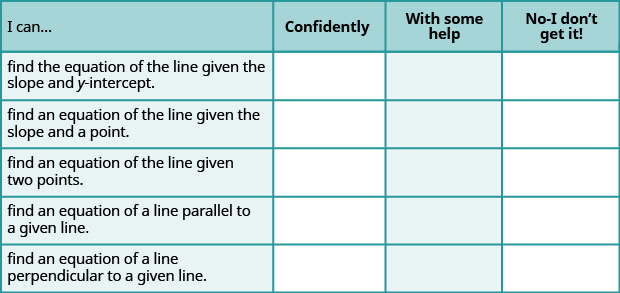
b. On a scale of 1-10, how would you rate your mastery of this section in light of your responses on the checklist? How can you improve this?


